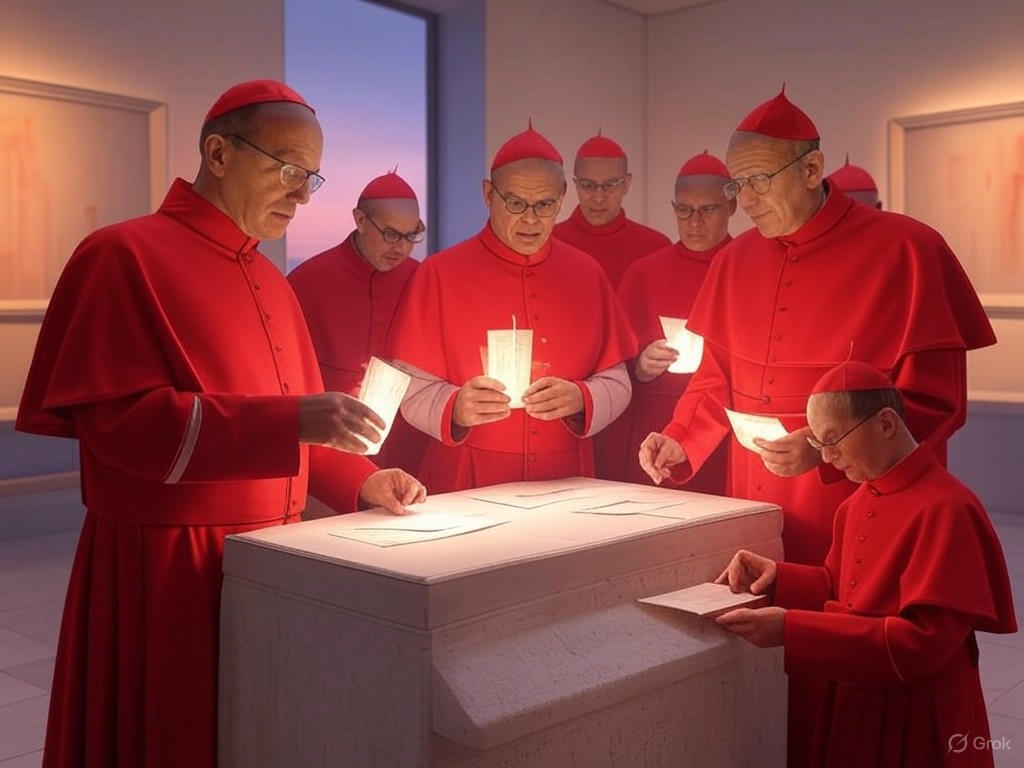
Papal Election Process Resembles Real-Life Traitors Game
Unveiling the Intrigue: A Game of Secrecy, Strategy, and Suspense
Have you ever pictured the papal election as a high-stakes drama, where cardinals navigate hidden alliances and whispers in the shadows? It’s a process steeped in mystery, much like the real-life Traitors game that keeps players guessing until the end. This secretive event, known as the conclave, draws parallels in its blend of strategy and suspense, making it a fascinating topic for anyone intrigued by human dynamics and tradition.
The papal election process stands out as one of the most guarded rituals in the Catholic Church, involving cardinals who must balance faith, politics, and personal convictions. Picture this: a group of electors isolated from the world, casting votes in secret rounds, where every decision could tip the scales. It’s not hard to see why it feels like a live version of Traitors, with its mix of trust and deception.
Over the centuries, this process has evolved while retaining its core elements of isolation and anonymity, ensuring that the chosen leader represents the global Catholic community. As we dive deeper, you’ll see how these elements create an atmosphere ripe for intrigue, much like gathering around a table for a strategic game night.
The Conclave: Setting the Stage for a High-Stakes Papal Election
When the papacy is vacant, the spotlight shifts to Vatican City, where the College of Cardinals assembles for what feels like an episode of high drama. Only cardinals under 80 can vote, bringing a fresh mix of wisdom and energy to the table for this critical papal election. With around 120 to 135 electors, they’re tasked with selecting a spiritual guide for over a billion followers—a responsibility that weighs heavily on every decision.
- Timing: The conclave kicks off 15 to 20 days after the vacancy, giving everyone time to prepare amid growing global anticipation.
- Eligibility: Age restrictions keep the process dynamic, focusing on cardinals who can bring modern perspectives to ancient traditions.
- Secrecy: Each elector swears an oath to maintain silence, turning the event into a sealed bubble of strategy and reflection.
The Role of General Congregations in the Papal Election Preparations
Before the main event, cardinals gather for general congregations, discussing the Church’s future and sizing up potential candidates. These sessions are like pre-game huddles, where ideas are shared and strategies quietly formed, all out of the public eye. Imagine the tension: cardinals from diverse backgrounds debating in private, much like players in Traitors plotting their next move without revealing too much.
This stage sets the foundation for the papal election, allowing for informal alliances that could influence outcomes. It’s a reminder that even in matters of faith, human elements like persuasion play a key role. These discussions often spark unexpected shifts, keeping the process as unpredictable as any reality show challenge.
Inside the Sistine Chapel: Where the Papal Election Game Intensifies
Stepping into the Sistine Chapel marks the true beginning of the drama, with its stunning frescoes serving as a backdrop to this intense gathering. The command “extra omnes” clears the room, locking the cardinals in for what could be days of voting and waiting. This isolation mirrors the Traitors game, where participants are cut off to build suspense and force genuine interactions.
The Mechanics of the Vote: A Strategic Dance
Each voting round is a masterclass in secrecy: cardinals write names on ballots crafted to hide their handwriting, then deposit them into a chalice. Three scrutineers count the votes, while others verify for accuracy, ensuring no room for error in this pivotal papal election moment. Rounds can happen up to four times a day until someone secures a two-thirds majority plus one vote, demanding careful strategy and patience.
- Ballots are designed for anonymity, preventing any tracing back to the voter.
- Infirmarii assist in collecting votes from those who can’t make it, maintaining fairness.
- Revisers double-check everything, underscoring the process’s commitment to integrity.
Comparing the Papal Election to the Traitors Game
How does this stack up against the Traitors game? Let’s break it down in a simple comparison to highlight the similarities.
| Feature | Papal Conclave | Traitors Game |
|---|---|---|
| Secrecy | Enforced with oaths and severe penalties, creating an airtight environment | Central to the thrill, with players hiding motives to outwit each other |
| Voting Process | Anonymous and iterative, building toward a decisive majority | Secret eliminations that ramp up the tension round by round |
| Psychological Strategy | Whispered alliances and candidate evaluations in a pressure cooker | Deception and deduction, where one wrong move can lead to betrayal |
| Outcome Announcement | Dramatic smoke signals that captivate the world | A reveal that shocks participants and audience alike |
This parallel shows how the papal election isn’t just a ceremony—it’s a psychological game where every vote counts, much like uncovering a traitor in a group setting.
The Human Drama: Alliances, Suspense, and High Stakes in the Papal Election
Behind the rituals lies a web of human stories: cardinals forging alliances based on shared visions or cultural ties, all while the world speculates outside. It’s easy to draw from Traitors here—think of the moments when trust frays and surprises unfold. What if a favored candidate falters, forcing a sudden shift in strategy?
- Black smoke: Signals no decision, ratcheting up the external suspense like a cliffhanger episode.
- White smoke: The triumphant “Habemus Papam” announcement, ending days of uncertainty.
The Rituals Enforcing Secrecy in the Papal Election
Secrecy isn’t optional; it’s sacred, with breakers facing excommunication to preserve the process’s purity. No phones, no leaks—just focused deliberation. This strict enforcement keeps outside influences at bay, much like isolating players in a game to heighten authenticity. Ever wondered how such rules prevent modern interference in an age-old tradition?
Strategies and Speculations: Navigating Paths to Victory in the Papal Election
In the thick of it, cardinals employ subtle persuasion, building coalitions that could make or break a candidacy. It’s a delicate balance of prayer and pragmatism, where one conversation might sway votes unexpectedly. Like in Traitors, where players must read between the lines, this phase turns the papal election into a test of intuition and resolve.
For instance, a cardinal from a developing nation might advocate for a pope attuned to global issues, creating ripples of support. These dynamics add layers of excitement, proving that strategy often trumps straightforward voting.
Rituals, Symbolism, and the Final Reveal of the Papal Election
The white smoke rising from the chapel isn’t just a signal—it’s the climax of weeks of tension, symbolizing unity and renewal. As the new pope steps onto the balcony, the world witnesses the end of a journey filled with strategy and soul-searching. This moment captures the essence of the papal election, blending ancient rites with profound human drama.
Conclusion: A Timeless Process That Captivates the World
The papal election remains a riveting spectacle, where secrecy and strategy converge in ways that echo popular games like Traitors. It’s more than tradition; it’s a reminder of how human elements shape history. What do you think—does this process keep the Church relevant, or is it time for updates? Share your views in the comments, and explore more on our site for insights into faith and culture.
References
- How a New Pope is Chosen. USCCB. https://www.usccb.org/offices/public-affairs/how-new-pope-chosen
- Papal Conclave. Wikipedia. https://en.wikipedia.org/wiki/Papal_conclave
- Election of a New Pope. Archdiocese of Boston. https://bostoncatholic.org/election-of-a-new-pope
- How the Papal Conclave Chooses a New Pope. CBS News. https://www.cbsnews.com/news/how-papal-conclave-chose-new-pope/
- Pope Conclave and Cardinals’ Papal Election Process. The Independent. https://www.independent.co.uk/news/world/europe/pope-conclave-cardinals-papal-election-process-b2743674.html
- Additional Resource. OAPEN Library. https://library.oapen.org/bitstream/20.500.12657/22854/1/1007307.pdf
- Video Explanation. YouTube. https://www.youtube.com/watch?v=1CxP49wtt0M
- Personal Insight. Aaron Aryanpur. http://aaronaryanpur.com/new-year/
papal election, conclave, papal conclave process, secret ballot, traitors game, Vatican election, Catholic Church rituals, papal voting, Church leadership, religious strategy






